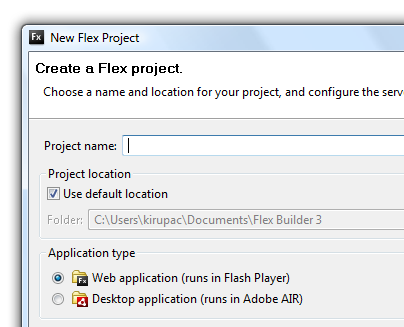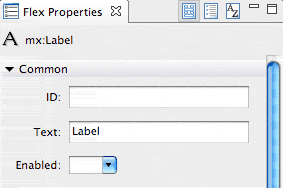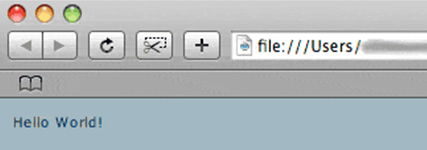by
Devin Columbus aka dColumbus | 10 March 2008
So let�s get you started by building your very first
Flex Application. Assuming you�re not a newly born human
or have recently crawled out from under a rock and have
decided that learning Flex is the first thing that your
heart desires, I�ll spare you the basic tour of the Flex
interface.
There are two ways of creating a Flex Application:
- Create a new Flex Project (
File | New | Flex Project
)
- Create a new Flex Application (
File | New | Flex
Application )
Now, the simple difference should be obvious; a Flex
Project can house all of the current projects assets �
ActionScript, Images, .SWF Files, and even other Flex
Applications. The Flex Application is kind of like the
index.html inside of a website root folder. It is the base
of your application and is what everything else if build
around. I hope that makes sense.
For this tutorial, we�ll be creating a new Flex Project.
Why? Well, the important thing to note here is that if you
haven�t already created one, there is no place to create a
singular Flex Application, or anything else for that matter.
Thus, we�ll create a new project called �HelloWorld.�
When the �Create a Flex Project� dialog first appears,
you can see that there are a few things to consider:

[ create a new Flex project first ]
First of all, you need to give the project a name, which
we decided is going to be �HelloWorld� (without the quotes,
of course). Now, I�m going to assume that you have a naming
convention that you have learned and tend to stick with, and
if you feel confident in your abilities, by all means, have
at it. For the sake of consistency on my end, I always name
a project capitalizing each word in the name, no spaces or
special characters � you�ll notice that even if you try to
use an unorthodox naming convention, it won�t let you.
Secondly, you are able to decide where your Flex
project(s) will live. I use the default folder structure on
my Mac, and in most cases, is automatically stored in your
systems default �Documents� folder.
The �Application type� specifies whether or not you would
like you Flex Application to run on the Web, or run as an
Adobe AIR (desktop) application. For now, let�s just stick
with �Web application� since it suites our needs at this
time.
Lastly, you can choose to associate a Server technology
such as ASP.NET, ColdFusion J2EE, PHP, or some Other server
language. We�re not going to associate this little test
project with any special languages, so just ignore that for
now. I STRONGLY SUGGEST that you take the time to click that
tiny little question mark at the bottom left of the dialog
box and learn the more about your options when creating a
new Flex Project. Don�t be shy, just do it� you�ll love it!
Click �Finish� and we�re off.
To add
functionality to the application, let�s make sure we�re in
the �Design� Mode. Once we�ve set up all of the visual
components on the stage, we�ll make our way to the �Source�
Mode so we can edit the code. Those buttons are located
towards the top of the main stage of your application.
Once in Design Mode, to the lower left-hand corner there
will be a Components Panel that houses all of the available
Flex Components. Take a look through the available
components and feel free to experiment with them once you�ve
completed this basic tutorial. Let�s select a �Label�
component and drag it to the stage. Go ahead and place it
anywhere, but as you do, you�ll notice that Flex will
automatically give you guide lines when you�re either close
to a corner, or right smack-dap in the middle of the Stage.
This is extremely useful when you�re trying to align your
components within the Design Mode.
The purpose of the
Label Component is to display a single line of text (i.e.
header names, pages titles, etc). Once your Label is in
place, there are two ways of editing it�s Text attribute.
One way is to simple double-click on the component and edit
it�s text right there. The second way directs us to the
all-important Properties Panel. You�ll see that to the right
hand side of the Flex IDE. There are a few things to note
that are arranged within the �Common� sub-category of the
Properties Panel:

[ your Properties panel ]
The �ID� field is the components identification, or for
you Flash users, it�s like the Instance Name that you can
give to any component with that available property. The
�Text� field, in this case, is the visual text property that
the Label component displays. Let�s set that to �Hello
World!� Lastly, the �Enabled� option let�s you decide
whether or not you would like your Label component to be
enabled or disabled. In this specific case, all this really
does it visually change the Label to a slightly greyed
�disabled� look and feel. Once we preview the application,
go ahead and change that property to �True� and you�ll see
what I mean.
On that note, let�s preview our very first
Flex Application. Towards the top of the Flex IDE, there are
a series of buttons:

[ the Flex IDE toolbar buttons ]
Let�s concern ourselves with the second set of controls,
the greenish ones. The fastest way to get familiar with
everything in the Flex IDE, is to just hold your mouse over
top of each icon and wait until the tool tip appears. The
big green button is the �Run� button, this will compile your
application and allow you to preview it just as anyone would
within the browser. The little bug icon is just that �
�Debug�. This is the button that you would want to press if
you wanted to debug your project and find out more
information as to why something isn�t working quite right or
check your �trace� statements. That�s all fine and dandy,
but for this application, let�s just stick to the �Run�
button. Go ahead and click it and let�s see the magic
happen. As you�ll notice, a couple of dialog boxes may shown
themselves, and in that case, just tell Flex to
automatically save your application if you so desire, and
move on. The Flex Builder will compile your entire
application and open a new browser window to display your
Hello World Label in all of it�s glory:

[ a default, simple style ]
As was explained in my previous tutorial, Flex generates
it�s own .SWF file, embeds it in an HTML file which is
automatically named according to your application name
(HelloWorld.html) and injects the appropriate JavaScript for
browser Flash Player detection and all of that jazz.
What I want you to do now, is explore the properties
panel and feel free to change the Label components Style
properties. Give it a different font, or set it as Bold, and
if you really want to go wild, you can click on the Stage
and change it�s Style properties and you may even end up
with something as freakishly stellar as this:

[ my really cool final output! ]
If you have any questions, feel free to post them on the
kirupa.com Forums.
 |
Devin Columbus
aka dColumbus |
|